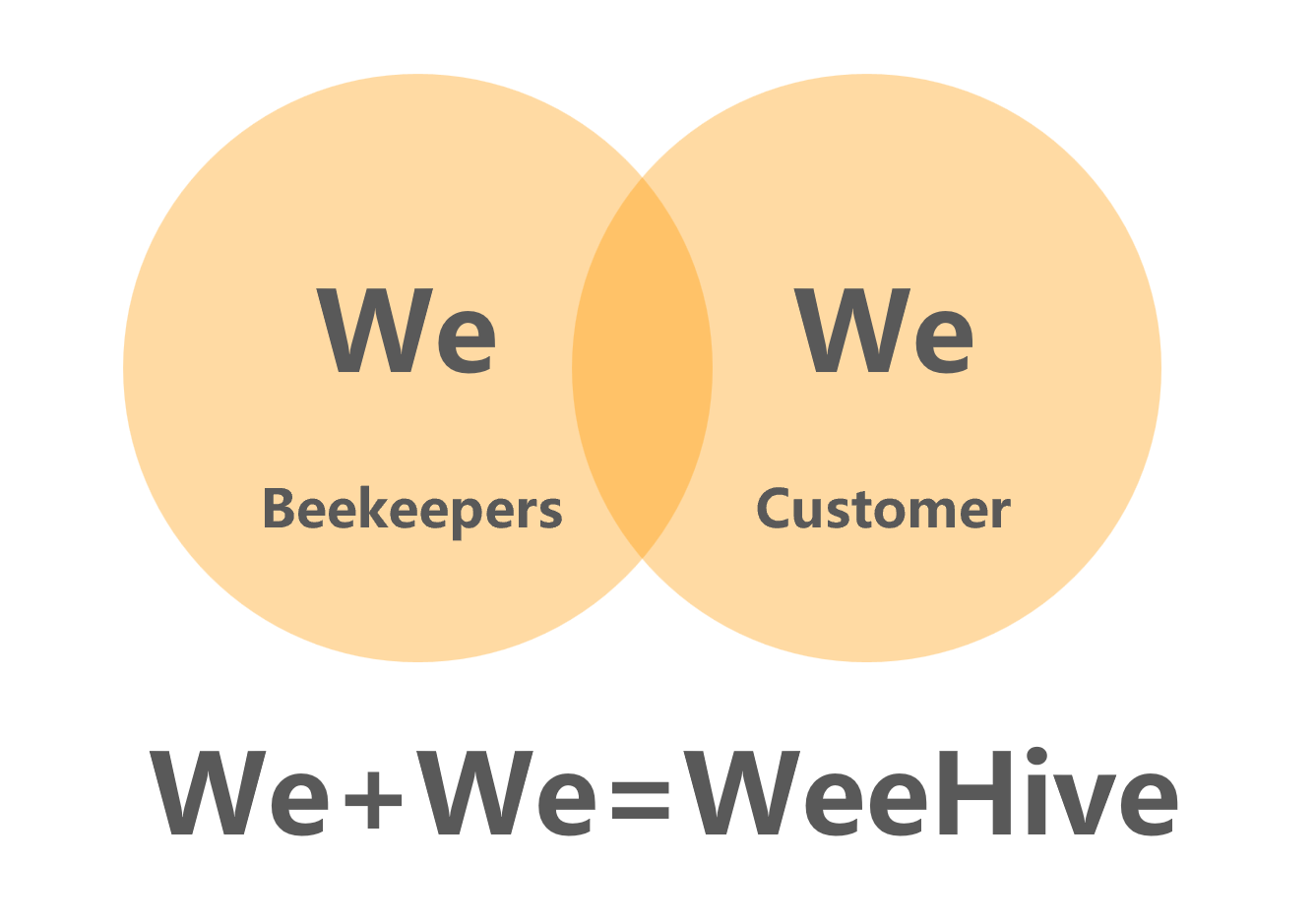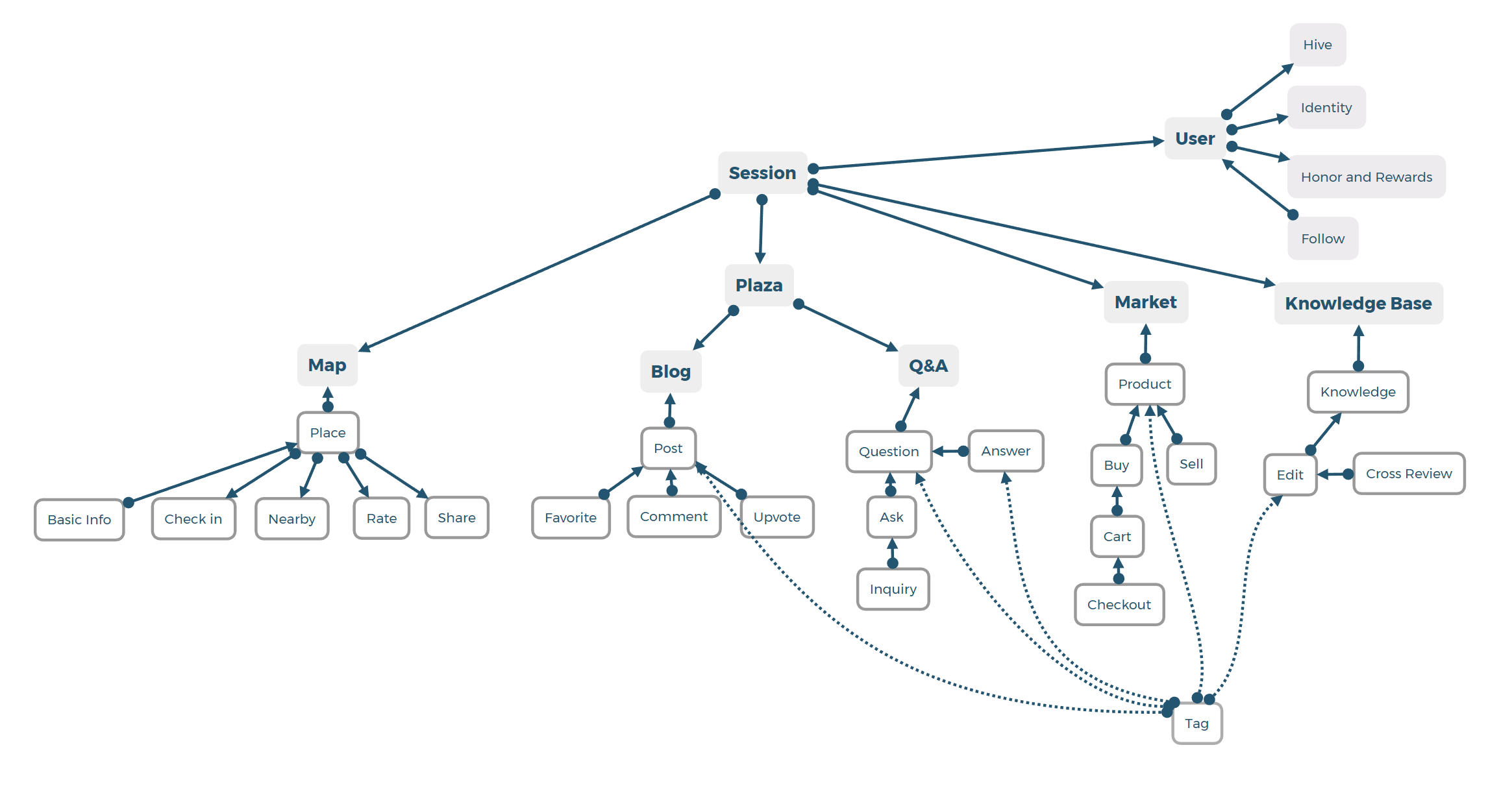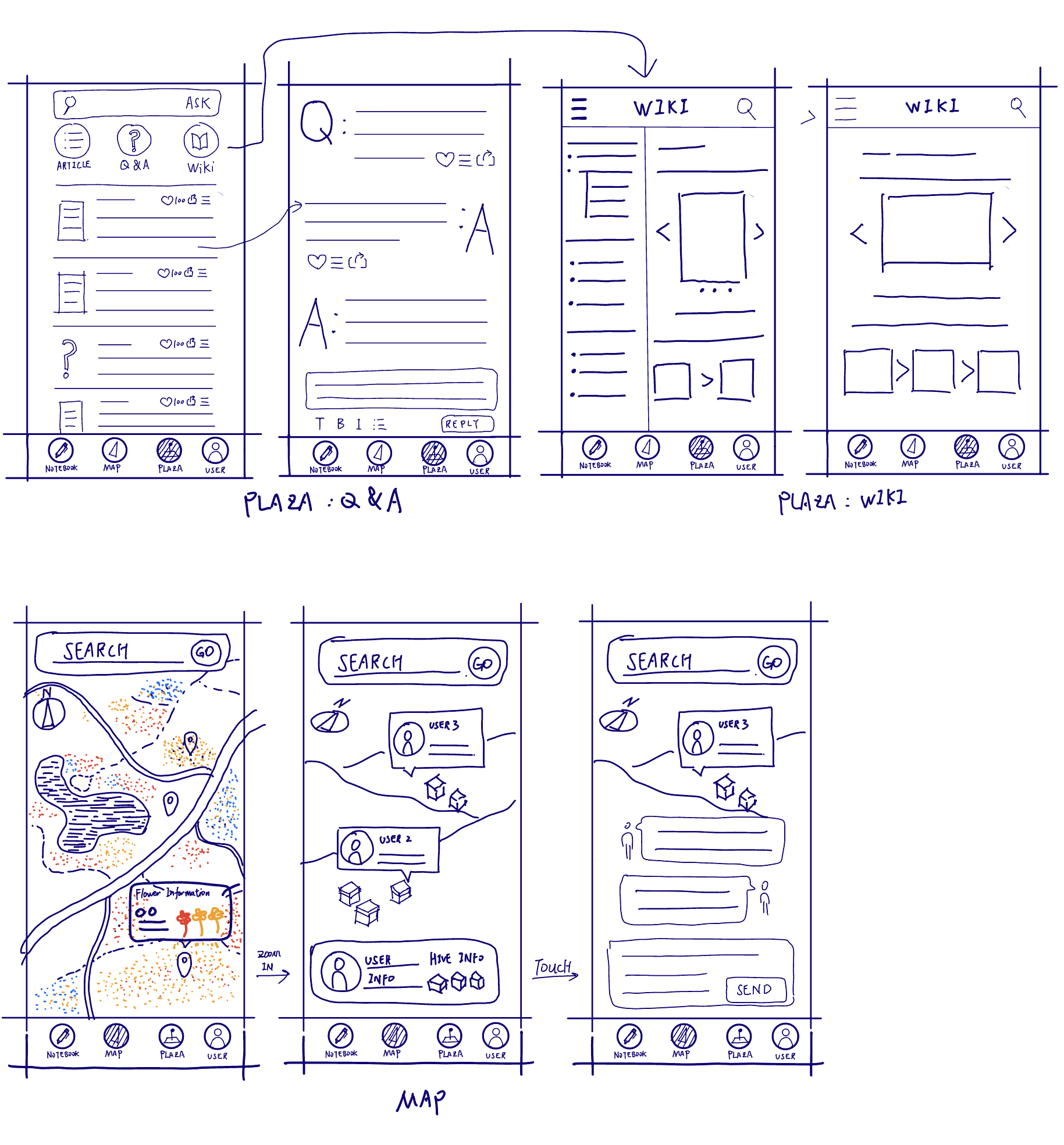Chapter 2: Divergent Design Document
App Name: WeeHive

Description: The name is inspired by seeing both beekeepers and customers as ”we”; we share a community connected by the beehive.
Audience:
- Tier - 1:Beekeepers
- Professional Beekeepers: Farmers rely mainly on bee products to survive, including honey, wax, pollen, and propolis.
- Amateur Beekeepers: farmers mainly grow crops or raise stocks but raise bees for a secondary income source or benefit from pollination by bees
- Beekeeping Hobbyists: people who are interested in beekeeping and want to keep it as a leisure activity
- Tier - 2: Customers
- Chefs and cooks
- Families
- Individual buyers
- Tourists
- Artists and Craftsmen
- Raw material acquirers
- Importers
- Tier - 3: Academical
- Environmentalists
- Researchers
- Students and Educators
- Tier - 4: Organizations
- Local bee product organization
- State or nationwide bee product organizations
- Animal Welfare NGOs
- governments
Key Values:
User-Friendly: user-friendly design for all-age users, with particular concern with young age (for education purposes) and old age (for elderly farmers)
Accessible: Consider being used by disabled (can’t hear, read, type, poor eyesight)
Inclusive: consider different user groups and stakeholders
Collaborative: encourage and facilitate collaboration with designed features
Resilience: take into account risk and unpredictable climate change
Informative: establish a mechanism to ensure high-quality knowledge sharing and filter out nonsense.
Efficiency: fast navigating to the required knowledge, direct share, Comment, and reply
Privacy: Ensure sensitive information is treated properly
Feature Brainstorming
- Identity Management
- Being able to view a selected range of contents without login
- Semi-anonymous identity system: To allow new users to join the platform under a nickname, with or without revealing their real name.
- Register, login, logout, edit profile, delete account
- Hive management: Register or delete hives under one’s account
- Honor and Rewards: Active users will be awarded prices that can show with others
- Identity verification: Normal users can submit necessary documents or undergo a process to verify their identity; once approved, they unlock corresponding identities, such as “beekeeper” or “expert,” to distinguish them from normal users.
- Location-Driven Online/Offline Social Experience
- Interactive Map: Users can navigate the map using gestures to zoom in/out and pan. Various markers or icons represent beekeepers and their hives.
- Create a Checkpoint Post: Once they arrive at a new place, the users will be able to create a checkpoint post to show off their achievement
- Local Community: Nearby users can identify each other and form local community
- Direct Messaging
- Two identified users can send a direct message
- Send rich text messages, including sound, video and images
- Data-Driven Online Community
- Blog: Post informative articles to the platform
- Q & A: ask and answer question
- Expert Inquiry: Ask questions to “expert” identity users
- Hive Analytics (Optional): Analyze the data reported from hives, and can be posted with the question
- Marketplace: Provide an online market for beekeepers to sell products and for customers to buy
- Interactive Beekeeping Knowledge Base
- Core content created by experts, systematic content logic
- Display animation and videos to show beekeeping techniques
- Verified User can edit the contents but requires a peer-review process before deployment
- Accessibility Features
- Easy Navigation
- Read aloud, big fonts, high contrast, dark mode
- Voice Commands
VSD (Value Sensitive Design) Analysis
| Stakeholders | Time | Pervasiveness | Values |
|---|---|---|---|
| Drawing from Value Sensitive Design methodology, the Stakeholder criterion emphasizes the range of effects of technology, both on those who are in direct contact with a technology (direct stakeholders) and on those who might not be direct users but whose lives are nevertheless affected by various interactions around the technology (indirect stakeholders). | Inspired by the long-term perspective of urban planning, the Time criterion helps guide designers to consider the longer-term implications of their work – implications that will only emerge after the technology has moved through initial phases of novelty to later phases of appropriation and integration into society. | Technologies can become pervasive with respect to geographic (e.g., city navigation software use within urban areas), cultural (e.g., text messaging within the deaf community), demographic (e.g., online social networking sites among teenagers), and other factors. | autonomy, community, cooperation, democratization, environmental sustainability, expression, fairness, human dignity, inclusivity and exclusivity, informed consent, justice, ownership, privacy, self-efficacy, security, trust, and universal access. |
Stakeholders: “Customers” can be considered as the 2nd-tier stakeholders in this project. The current platform may primarily be designed for the direct stakeholders (beekeepers). It may expose too many unnecessary functions to the users who want to buy the product, such as a jar of honey. Therefore, we may define states according to the User’s purpose to hide the unrelated features for indirect stakeholders.
Stakeholders: Children may find text-heavy knowledge platforms not informative, so the purpose of education needs to be considered. The interface should also be friendly enough to be intuitive, such as displaying icons using hand gestures to control, to be used by most people, including Children.
Stakeholders: Non-targeted Use: The part of the program that is intended to be a agricultural forum, can be used as a place to share daily life, which may cause distruption of proper usage. In this case, the program should consider informal conversation, such as open a spearate forum, give people flexibility of discussion, while perserving the core functions of the program.
Time: When software is released for a long time, some users will no longer use the platform. Content generated by them may no longer respond to the original author. Some expert users may also continue to receive questions after they stop using the platform. So, we need to establish a mechanism to identify infrequent users. Inactive users’ content could be managed by the platform in the public realm.
Time: I believe as time goes by, the application can be intergrated as an embedded part of IoT eco-system. For example, the app can be cross-platform, especially on wearable devices. In such case, new input methods can be introduced, such as reading the hand gestures.
Pervasiveness: For the global market, different production/supply chains may affect product consistency. Language gaps may be an obstacle to realizing the products’ value and functionality. Therefore, when the platform expands to the international market, we need to localize and optimize it for representative markets.
Pervasiveness: Each region may have its own regulation. It is necessary to identify the legal boundary to avoid risks. For example, some countries may have strict law not allowing beekeeping in the urban area. The program, designed as a social platfrom, may have the risk of becoming a virus starting a trend of urban beekeeping. So we may make use of graphical limitation on such risks according to local laws.
Pervasiveness: For markets such as China, people heavily rely on WeChat to communicate and see it as the entry point of the Internet, especially farmers. In such cases, it is necessary to adapt to such a platform. For example, create a WeChat mini-app version that can be run directly within the WeChat software to enable easy access to target users.
Pervasiveness: Beekeeping production environment is harsh. During summer, the farmers directly face the sun, with chaotic bee sound surrounding, wearing a glove and mask. It is necessary to have display mode suits this scenario, including high contrast, big display elements, and reduce the steps to achieve operations.
Values: The perceptions of value may change over time, and it is necessary to identify the trend to adjust the platform design and the user experiences. For example, if User friendly is one of the key values of the platform, when we migrate to another platform, such as Apple Vision, the way of defining “user-friendly” may have another dimension under the AR environment. A new series of navigation designs may be initiated to adjust the change.
Concepts
• Identifying concepts. See this tutorial for criteria that you can apply to ensure that your concepts really are coherent concepts and not just arbitrary pieces of functionality. You can also read more about identifying concepts in Chapter 2 of Daniel’s book The Essence of Software.
| Name | Purpose | Operational Principle |
|---|---|---|
| User, Session | A semi-anonymous identity system allows users to use their nickname, but only verified users can unlock the full features. | User can register their own identity, they can log in and log out, and edit their identity, including nicknames, icons, contacts, and preferences. They can also delete their account permanently. |
| Post | Enable the users to share the knowledge they already have | In the blog page, the users can post an article/material that doesn’t necessarily require a reply(answer) |
| Comment | Enable the users who leave their thoughts to establish engagement and interaction | Comment on a post/answer to show one’s idea on one topic |
| Connect | Enable the users to keep track of the updates of the other users they like, and opens easier direct contact possibility | Follow an author to keep up with their posts, free to direct message to them |
| Ask | Users can raise their questions and get answers | Users can create a “question” that requires an answer in the community |
| Answer | A special kind, knowledge-oriented post connects to a question. | When a question is posted, the User can answer it below by inputting it into a textbox. |
| Upvote | A mass-voting mechanism to identify good quality content from the community | Users can upvote by clicking a button next to a post/answer. Good quality content will rise to the top of the answer list |
| Favorite | Save articles and answers for later review | if mark item, can select and view later |
| Map | An interactive map as a deck for users to view worldwide beekeepers’ status and access them remotely. | The map is one of the main pages of the app. People can use gestures to navigate the world and access resources intuitively. |
| Hive | An object belonging to the User representing beehive hardware | Storing basic info, location, and environmental data, then shown on the map |
| Checkpoint | To enable the users to record the places they have been to | When arriving at one place, check in to record “I have been here,” then optionally generate a post |
| Rate | To rate the flower source quality of the location | After leaving the location, prompt the User to rate the location as having good/no good flower source for honey |
| Nearby | To enable location-based user interaction, to create a local community | If two users are geographically within a range, they can be considered “nearby.” The User can only see a vague location unless directly sent location. |
| Place | A concept including the location and information of a place on the map as a point of interest | User can see places as points of interest on the map page. They can click in to see detailed information. |
| Share | To enable the User to share the contents within the platform to other social media or websites | The User can click a button to easily share the articles and answers to other platforms. |
| Plaza | The main page to display User-created content, including user-posted articles, questions, and answers | Separate the non-official content with official-proved, systematic content |
| Knowledge Base | An officially approved, systematic, content-rich knowledge base mainly for Users to read, like Wikipedia or user manual. | User can read and comment on the knowledge pages in the content database. It can be used offline and online. In online mode, users can create new knowledge, but this session requires peer review and should follow the structure of the knowledge outline. |
| Inquiry | A pairing system for the users in need to connect with experts | In the question editing page, Users can search for their desired experts and establish public or private connections. |
| Tag | Tag separate articles and questions, which are all considered user-created content, making them able to be displayed on one single page and can be filtered. | Tags are created when the user posts. Article answers have their default tags. |
| Honor and Rewards | A system to reward hardworking content contributors for their hard work and provide benefits to them | The more articles users posted, the more read and liked the User received, the more honors the users would gain. |
| Identity | Distinguish between experts, administrators, and ordinary users | Users are assigned an ordinary identity when initially registered. Once confirmed or received a certain number of honors, their identity can upgrade to “experts.” |
| Market | Enable the users to sell and buy products with the help of the social network | Producers can access the “market” page to post their products. Customers can view, select the product, add it to the cart, and checkoff |
| Cart | A place to temporarily store the selected products, waiting to be purchased | After selecting the products from the market, the users can view and |
| Checkoff | Purchase the products | After confirmed in the cart page, the users are directed to the checkoff page |
Dependence Diagram
Construct a diagram of your concepts that shows, for each, which other concepts must be included for the inclusion of that concept to make sense. This diagram defines (implicitly) the different possible subsets of concepts that form a reduced version of your app, which will be helpful to you in the next assignment when you decide which concepts you’re going to build.

UI Sketching
Pick two or three concepts that you think are the most interesting or novel of the concepts you’ve come up with, and draw a user interface sketch that conveys how the concept is realized and used. Hand-draw your sketch using pencil and paper (or a drawing app on a tablet), and see the advice section below for more details. Feel free to annotate your sketch to add any explanation you think is needed or to connect it to the concept OP.
